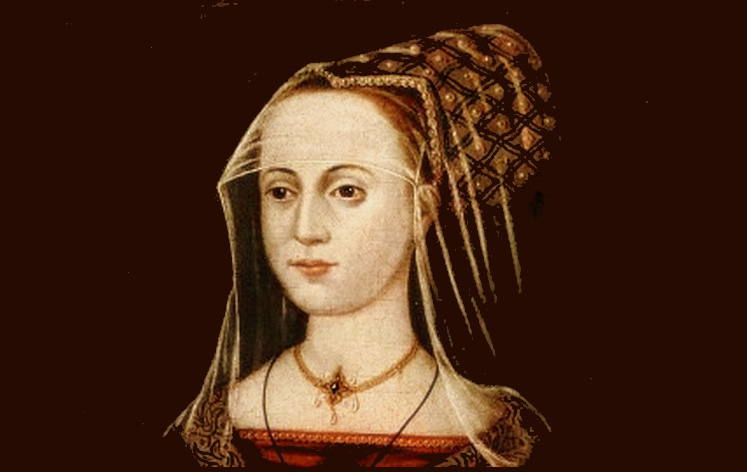Both femme fatale and mater dolorosa are male constructs of types of women which set them aside: one threatening, the other confirming male domination…
It is to be doubted that we will ever find the real Elizabeth. That person, whoever she was has been overlain by 500 years of historical writing. Like all medieval queens she has been stereotyped by a male dominated tradition. What is particularly intriguing about her history, in distinction from the histories of most other queens who have tended to be deified or vilified, is that the two have continued to exist alongside each other – A.J. Pollard “Elizabeth Woodville and her Historians”
There is an older tradition of Elizabeth Wydeville as the mater dolorosa, one born of hindsight and natural human empathy. It sits uneasily next to the scheming, ruthless and villainous Elizabeth Wydeville that has been largely created in the last two centuries, the temptress, the murderess and the sorceress. The truth behind Elizabeth’s reputation is that much of it has been shaped by her historians – and it is femme fatale image that lingers today.
We have examined Elizabeth’s marriage, her tenure and her life after her husband’s death. Today we are joined by David Baldwin, Susan Higginbotham and Arlene Okerlund to discuss the creation of Elizabeth Wydeville’s reputation.
You have all written balanced accounts of Elizabeth Wydeville’s life, why did you decide that Elizabeth’s reputation needed reassessing?
David Baldwin: It could be argued that it is impossible to take a favourable view of both Elizabeth and Richard III in the context of what happened after Edward IV died. Historians who have sought to rehabilitate Richard’s reputation think much of the blame lies with her.
Susan Higginbotham: I came to Elizabeth Woodville first through reading historical fiction, and her portrayal in the novels I read was so unsympathetic, I started questioning whether she was really as bad as she had been portrayed. I began doing research, and I learned that the real Elizabeth was far different from the caricature we see in so much fiction–and in popular nonfiction.
In my own book, I didn’t set out to reassess Elizabeth in particular, as there had already been scholarly reassessments of Elizabeth, particularly by Livia Visser-Fuchs and by Anne Sutton, as well as excellent biographies by Arlene Okerlund and David Baldwin. I chose instead to focus on the family as a whole, which had been equally disserved by popular accounts.
Arlene Okerlund: Historians had bestowed a reputation upon Elizabeth Wydeville that amounted to no less than slander. They either negligently—or willfully—ignored the source, context, and perspective of the attacks against her: they turned propaganda into fact. Time was long overdue to set the record straight by re-evaluating contemporary evidence.

What are some of the most damaging charges against Elizabeth in your opinion?
David Baldwin: Perhaps the most damaging are the allegations that she incited the judicial murders of the Earl of Desmond and the Duke of Clarence. But Charles Ross has dismissed the Desmond story, and, while she had every reason to fear Clarence’s ambitions, it was only later innuendo that said she urged her husband to put him to death.
Susan Higginbotham: Perhaps the worst story about Elizabeth is that she tricked her husband into ordering the execution of the Earl of Desmond out of pique for a comment he had made about her marriage years before. The story comes from sixteenth-century sources and doesn’t hold up at all well under scrutiny. Fortunately, it hasn’t had the staying power as some of the other stories about Elizabeth, perhaps because the more popular recent novels about Richard III don’t include it.
Two other stories, however, have proven to be almost unshakable. One is the tale, reported as a rumor by Mancini, who clearly identified it as such, that Elizabeth, her son the Marquis of Dorset, and her brother Edward ran off with the royal treasury. In fact, Rosemary Horrox, who has studied the royal finances from this period, has shown that there wasn’t much royal treasure to run off with. It also defies logic that if Elizabeth did indeed have stolen treasure with her in sanctuary, that Richard, first in his role as Protector and later in his role as king, would do nothing to recover it from Elizabeth. There is an observation by Simon Stallworth in a contemporary letter that “where so ever can be found any goods of my lord Marquis it is taken,” which has been used by some to bolster the stolen-treasure story, but Stallworth clearly refers to the Marquis’s own goods, not to crown goods. As for Edward Woodville, he did seize a large sum of money from a merchant ship before fleeing into exile, but that the time of the seizure, he was acting on behalf of Edward V’s government and does not seem to have yet been aware of Richard’s coup against his family.
The second story has no contemporary basis at all, but originates with Paul Murray Kendall, a biographer of Richard III whose contempt for the Woodvilles knew no bounds. He claimed that no official word of Edward IV’s death was ever sent to Richard, thereby giving rise to the notion that the Woodvilles concealed the king’s death from his brother. In fact, no contemporary sources indicate that there were any irregularities in the way that Richard learned of his brother’s death. Indeed, since the news was current in Calais the day after Edward’s death and the king’s body had been displayed, it’s hard to see how the Woodvilles could have kept Richard from finding out about Edward’s death even if they had wanted to do so.
Arlene Okerlund: The charges that Elizabeth Wydeville was a social climbing, grasping, greedy woman were the most damning in a world where pride and avarice were two of the deadly sins. Medieval culture viewed hierarchy as ordained by God and an indication of personal value. The earl of Warwick’s claim that the Wydeville family was “low born” was propaganda, but damning to those who chose to believe it. [I smile every time I envision Warwick’s apoplexy when Elizabeth’s mother, Jaquetta, Duchess of Bedford, was seated above the Countess of Warwick at royal banquets.]
Were all contemporary views of Elizabeth negative?
David Baldwin: No. The Croyland writer recorded how in April 1483 ‘the benevolent queen, desirous of extinguishing every spark of murmuring and unrest’ tried to appease Hastings by limiting her son’s escort to 2,000 men, and the citizens of Coventry and a Londoner who dedicated verses to her emphasised the antiquity of the House of Luxembourg and applauded her fortitude during her husband’s exile.
Susan Higginbotham: No. The Crowland chronicler takes a positive view of Elizabeth, and she was praised for her forbearance during her husband’s exile in 1470-71. While she doesn’t seem to have been as popular as Queen Philippa in the fourteenth century or as her daughter Elizabeth of York, she was never a controversial figure as, say, Margaret of Anjou or Anne Boleyn.
Arlene Okerlund: Many contemporary documents idealize Elizabeth. In Italy, Antonio Cornazzano’s poem “La Regina d’ingliterra” commended Elizabeth for her virtue in resisting Edward’s sexual advances. Stories of her modesty and courage had reached the European continent soon after their marriage. In England, Fabyan’s Chronicles commended Elizabeth’s “constant womanhood, wisdom, and beauty.” Mancini cites her “beauty of person and charm of manner” and a virtue that could not be corrupted by “gifts or menaces.” Thomas More’s account of the meeting of Edward and Elizabeth similarly describes her courage, virtue, and wisdom.
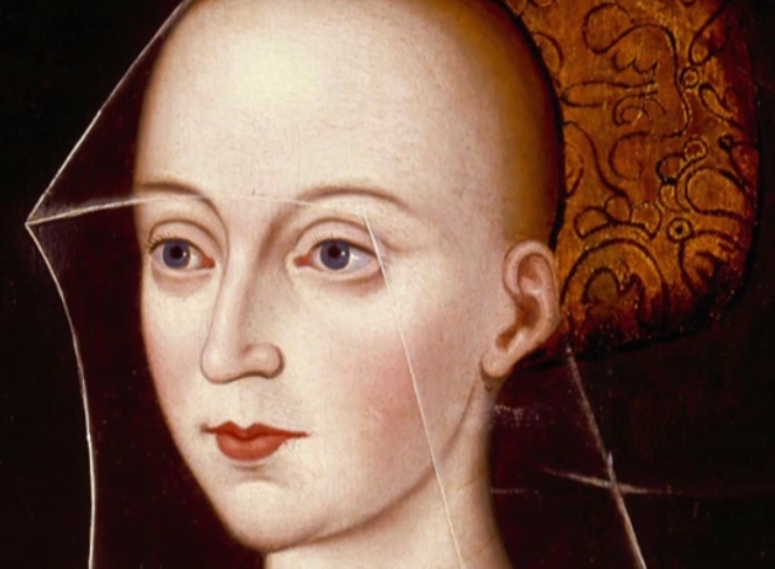
How do you think later historians have perpetuated some of the myths surrounding Elizabeth?
David Baldwin: By not bothering to question the assumptions of others – but constant repetition does not make an opinion any more correct.
Susan Higginbotham: Through repeating secondary sources instead of going to the primary sources, through selectively reading primary sources or reading them out of context, and through not using what my mother would call common sense.
Arlene Okerlund: Unfortunately, academic tradition plays an important and negative role: once an eminent historian takes a position, subsequent scholars tend to fall in line and follow the leader. Polydore Vergil reported that Henry VII “deprived” Elizabeth of all her possessions as punishment for compromising with Richard III, then forced her into exile at Bermondsey Abbey. Subsequent historians speculated that the Simnel rebellion caused the animosity between Henry and the Queen Dowager. Pure speculation turned into historical “fact.”
Similarly, many historians accepted Warwick’s propaganda against the Queen and her Wydeville family as truth without evaluating the source and context of the allegations.
Why do you think so many sexist traditions that surround Elizabeth Wydeville, such as the femme fatale, are still taken seriously now, in a time where we should be dismissing this sort of stereotyping?
David Baldwin: Elizabeth was a woman operating in a male-dominated society, a society which believed that members of her sex had no place in politics or government except on the rarest of occasions. Some of these prejudices still linger today.
Susan Higginbotham: I think it’s because a lot of people prefer to think of historical figures as heroes and villains instead of in shades of gray. I don’t think it’s really sexism at work, because some of the authors most wedded to the negative portrayal of Elizabeth are women.
Arlene Okerlund: Stereotypes are hard to dismiss because an element of truth forms their base. Modern novelists exploit such stereotypes in sensationalizing fiction: Philippa Gregory turns Elizabeth and her mother Jaquetta into femme fatale witches, a gimmick perpetuated by the BBC series The White Queen. Truth suffers in the interest of selling books—and the stereotype lives another day.
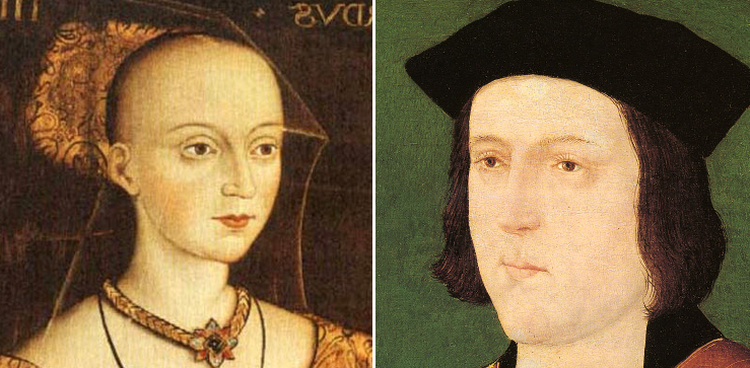
Why do you think the witchcraft charges against Elizabeth and her mother have had such a lasting impact?
David Baldwin: Perhaps because this is the allegation that intrigues us most. Those charged with this serious and highly damaging crime had no means of proving their innocence, and we will never know if Elizabeth and her mother really did use magic to influence events or if their enemies assumed they did. Their enemies supposed King Edward would not have married Elizabeth in the first place unless his usual good judgement had been overridden by a malign force.
Susan Higginbotham: I think it is because for modern readers, it “sexes up” her story. And, of course, historical fiction has had an enormous impact here.
Arlene Okerlund: The medieval world took charges of witchcraft seriously because witchcraft explained things that otherwise seemed irrational: why else would Edward IV, a handsome king who could have his choice of European brides, marry an English widow who was five years older than himself and already had two sons?
Centuries of scientific thinking should have taught us not to perpetuate such myths, yet even today, we grasp for explanations of phenomena that seem otherwise inexplicable. Jokingly (I hope), we say we were “bewitched” by someone. Plus, there is the creative human imagination that loves to roam wildly through novels and films that feature vampires–or wizards in Hogsmeade.
What is perplexing is the fact that serious scholars have repeated the myths of witchcraft surrounding Elizabeth Wydeville and her mother, Jacquetta, as if they should be taken seriously. Rather than analyzing the source of the accusations (and stating clearly that Jacquetta was formally cleared of Thomas Wake’s charges in January 1470), the continued reporting of the allegations persuade non-critical thinkers that they may be true (where there’s smoke, there’s fire—even though the “smoke” could be fog!)
When novelists add witchcraft to a fictional plot in the interest of sensationalism, rather than the larger truth that fiction can embody, the myths are perpetuated. It is perplexing because the events of Elizabeth Wydeville’s life tell a much more compelling story than the silliness of witchcraft.
No evidence connects Elizabeth Wydeville with witchcraft.
It would be almost instinctual to feel pity for a woman who had lost her children, yet Elizabeth is heavily criticised for handing her youngest son over to Richard III. Do you think this is a deliberate misinterpretation of the reality of the situation she was in?
David Baldwin: According to Thomas More’s account Elizabeth came under intense pressure to surrender Prince Richard, and only did so reluctantly after the Archbishop of Canterbury had assured her that he would come to no harm. She had few options and again, did the best she could.
Susan Higginbotham: I don’t think it’s so much a deliberate misinterpretation as a combination of hindsight and an inability to appreciate the mindset of the time. Richard sent the Archbishop of Canterbury. Backed by a group of armed men, to persuade her to allow her son to leave sanctuary; it would have taken an exceptionally bold woman to resist that type of pressure.
Part of the difficulty here is that we don’t know how much Elizabeth knew at the time. Had she learned of the execution without trial of Hastings a few days before, and if so, did she believe that she had lost an ally or an enemy?
Arlene Okerlund: Most people believe that Elizabeth delivered her son directly to Richard III, but she did not. The man to whom she entrusted her youngest son was Thomas Bourchier, Cardinal Archbishop of Canterbury, and the prelate in whom she placed ultimate trust. The Archbishop of Canterbury had crowned her husband and herself, had advised her spiritually throughout her reign, and was God’s highest representative in England. If she could not trust the Archbishop of Canterbury, what other possibility was there?
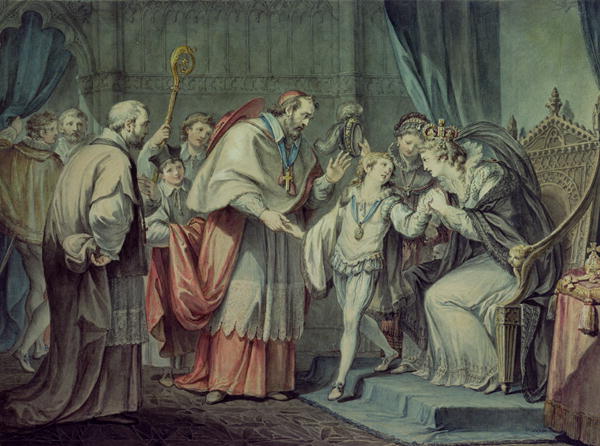
Why do you think people are unwilling to let go of the traditional view of Elizabeth Wydeville?
David Baldwin: A popular perception, once established, is very difficult to alter. Richard III is the prime example of this.
Susan Higginbotham: In large part, I think it’s related to the romanticized view of Richard III that has taken hold in the last few decades, though historical fiction and popular nonfiction such as Paul Murray Kendal’s biography of Richard. If you have a romantic hero, you have to have a pantomime villain, and Elizabeth Woodville, along with Henry VII and Margaret Beaufort, has filled that role for many.
Arlene Okerlund: Received opinion is difficult to change. Within the academic world, young professors tend not to challenge eminent scholars, who control their careers and who have written books that perpetuate claims of Elizabeth’s “low born” status, her “over-reaching ambition,” her “greedy, grasping nature.”
Others simply resent intelligent, courageous women who can hold their own with men.
What is the most important aspect of Elizabeth’s character that needs reassessing, in your opinion?
David Baldwin: The whole concept that the Woodvilles were collectively a ‘bad lot’, when in reality they were among the King’s and the House of York’s loyalist supporters. Yes, most of them were out for what they could get, but so too were Richard of Gloucester, Warwick the Kingmaker and all the rest.
Susan Higginbotham: I’d like to see more study of Elizabeth’s religious life and of her patronage, which has been overshadowed by the notion–grounded in the accusations of her enemies–that she was a practicing witch. We have documentation of her pious acts, though it’s difficult at this juncture to know whether this was motivated by deep piety on her part or whether she was simply doing the things that were expected of a medieval queen.
Arlene Okerlund: Elizabeth Wydeville represents the survival of the human spirit when afflicted with unimaginable—one would think unbearable—suffering, trauma, and pain.
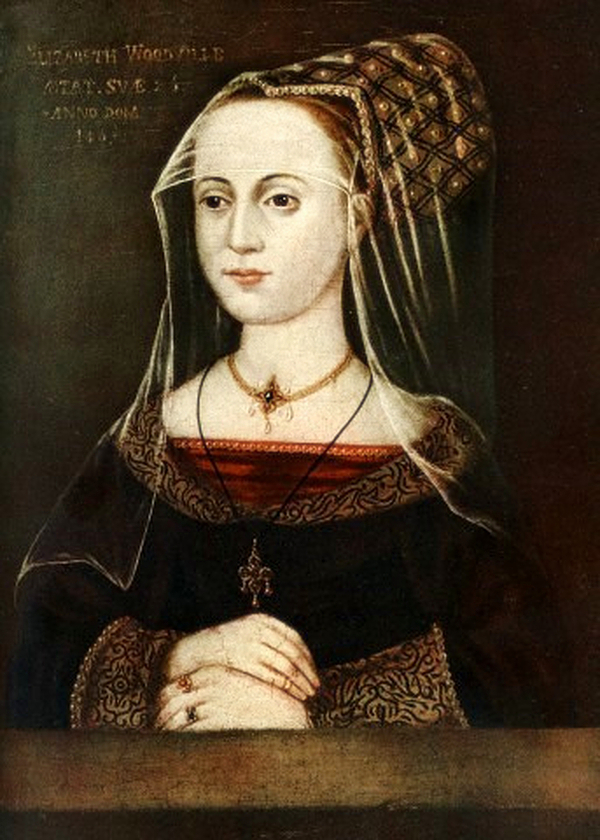
Many thanks to the wonderful David Baldwin, Susan Higginbotham and Arlene Okerlund for their hard work in contributing to this series. We hope that you have seen a new side of Elizabeth this week.
Our thanks to The History Press for organising the eBook giveaway. You still have until Sunday the 5th of October to get your entries in. We have one copy each of Elizabeth Woodville: Mother of the Princes in the Tower by David Baldwin, The Woodvilles by Susan Higginbotham, and Elizabeth Wydeville: The Slandered Queen by Arlene Okerlund. Just leave a comment on the articles to enter.
The Marriage of Edward IV and Elizabeth Wydeville with Susan Higginbotham
Elizabeth Wydeville: Elizabeth the Queen with David Baldwin
Elizabeth Wydeville: The Queen Dowager with Arlene Okerlund
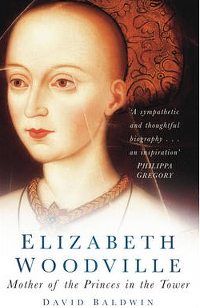
|
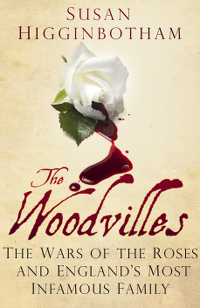 The Woodvilles:The Wars of the Roses and England’s Most Infamous Family The Woodvilles:The Wars of the Roses and England’s Most Infamous Family |
 Elizabeth: England’s Slandered Queen Elizabeth: England’s Slandered Queen |
 David Baldwin is a Fellow of the Royal Historical Society who devised and taught courses for adults at the Universities of Leicester and Nottingham for more than twenty years. His 2002 biography of Queen Elizabeth Woodville (Elizabeth Woodville, Mother of the Princes in the Tower) has been reprinted many times, and his other books include Stoke Field. The Last Battle of the Wars of the Roses (Pen & Sword, 2006), The Lost Prince, The Survival of Richard of York (The History Press, 2007), The Kingmaker’s Sisters, Six Women in the Wars of the Roses (The History Press, 2009), The Women of the Cousins’ War [with Philippa Gregory and Michael Jones] (Simon & Schuster, 2011), Richard III (Amberley, 2012), and Richard III, The Leicester Connection (Pitkin, 2013).
David Baldwin is a Fellow of the Royal Historical Society who devised and taught courses for adults at the Universities of Leicester and Nottingham for more than twenty years. His 2002 biography of Queen Elizabeth Woodville (Elizabeth Woodville, Mother of the Princes in the Tower) has been reprinted many times, and his other books include Stoke Field. The Last Battle of the Wars of the Roses (Pen & Sword, 2006), The Lost Prince, The Survival of Richard of York (The History Press, 2007), The Kingmaker’s Sisters, Six Women in the Wars of the Roses (The History Press, 2009), The Women of the Cousins’ War [with Philippa Gregory and Michael Jones] (Simon & Schuster, 2011), Richard III (Amberley, 2012), and Richard III, The Leicester Connection (Pitkin, 2013).
David Baldwin’s Facebook Page.
Read more: History Salon: The Survival of the Princes in the Tower
And Every Tale Condemns me for a Villain: Richard III with David Baldwin
 I am the author of two historical novels set in fourteenth-century England: The Traitor’s Wife: A Novel of the Reign of Edward II and Hugh and Bess. Both were reissued in 2009 by Sourcebooks.
I am the author of two historical novels set in fourteenth-century England: The Traitor’s Wife: A Novel of the Reign of Edward II and Hugh and Bess. Both were reissued in 2009 by Sourcebooks.
My third novel, The Stolen Crown, is set during the Wars of the Roses. It features Henry Stafford, Duke of Buckingham, and his wife, Katherine Woodville, as narrators. My fourth novel, The Queen of Last Hopes, features Margaret of Anjou, queen to Henry VI, and is set mainly in the earlier years of the Wars of the Roses. It was released in January 2011. My fifth novel’s, Her Highness, the Traitor, heroines are Jane Dudley, Duchess of Northumberland, and Frances Grey, Duchess of Suffolk, who respectively were the mother-in-law and the mother of Lady Jane Grey.
Visit Susan at History Refreshed and find out more about her books at susanhigginbotham.com.
Read more: The Woodvilles: Behind the Myth with Susan Higginbotham
Arlene Okerlund, Professor Emerita of English, retired after a career of teaching Renaissance literature at San José State University in California. After several years in the classroom, she served six years as Dean, College of Humanities and the Arts, and seven years as Academic Vice President before returning to her first loves of teaching and research. The author of scholarly articles on Shakespeare, Spenser, Marlowe, Donne, and Dryden, Professor Okerlund also writes for popular audiences, including the newsletter of the Peninsula Banjo Band with which she plays tenor banjo.
Currently, she teaches at the Osher Lifelong Learning Institute at Santa Clara University and lectures at The Institute for the Study of Western Civilization in California.
Arlene is the author of Elizabeth Wydeville: The Slandered Queen, published by The History Press, and Elizabeth of York published by Palgrave Macmillan.
Visit Arlene at San Jose State University.
Read more: The Red Rose and the White: Elizabeth of York with Arlene Okerlund

